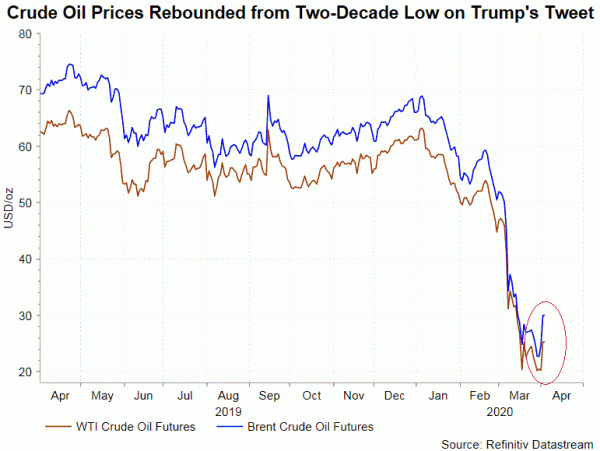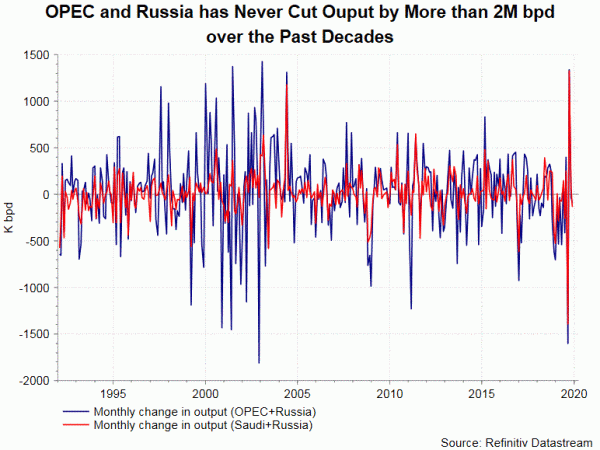Crude oil prices rebounded yesterday, on speculations that Saudi Arabia and Russia might agree to cut output. Donald Trump noted on Twitter that he expects that Saudi Arabia and Russia will reduce oil production by “approximately 10M bpd, and maybe substantially more which, if it happens, will be GREAT for the oil & gas industry”. The oil market was thrilled by the tweet. The front-month WTI crude oil jumped to a 2-week high of 27.39 before settling at 25.32, up +24.7%. The corresponding Brent contract rose to as high as 36.29, highest since March 12, before ending the day at 29.94, up +21%. However, Saudi is not interested in a deal between Russia and itself. Rather, it has called for coordinated output cut by majot producers, including the US, Canada and Brazil..
 In light of the severity of the coronavirus pandemic, global oil demand declined in 1Q20 and is expected to dive in the second quarter. It appears there are not many choices for producers but to trim production. The problem is the size and timing of the cut. We doubt if a reduction of 10M bpd is feasible, and if it is, whether it can lower the surplus. Moreover, the negotiation process would be lengthy.
In light of the severity of the coronavirus pandemic, global oil demand declined in 1Q20 and is expected to dive in the second quarter. It appears there are not many choices for producers but to trim production. The problem is the size and timing of the cut. We doubt if a reduction of 10M bpd is feasible, and if it is, whether it can lower the surplus. Moreover, the negotiation process would be lengthy.
Oil prices slumped in early March as Russia’s refusal to join OPEC in extending production quota, a deal ended on March 31, triggered retaliation from Saudi Arabia. The kingdom lowered prices of all grades of oil it exports and commanded its state-owned producer, Saudi Aramco, to raise the maximum production rate to record highs of 13M bpd. Prices of crude oil benchmarks sank by over 50% in just three weeks. Hopes that the two oil giants could agree to reduce output would be exciting news.
We doubt if Trump’s expectation that Saudi and Russia would agree to cut output by 10M bpd is practical. As the world’s second and third largest producers, oil output by Russia and Saudi averaged at 10.8M bpd and 9.8M bpd, respectively, in 2019. A 10M bpd reduction would mean cutting output of each by half. History suggests that major OPEC members and Russia have not trimmed output by more than 2M bpd over the past decades.

 While Russia has pledged not to raise output further this year and signaled willingness to return to the negotiation table, Saudi has called for a more coordinated output cut. This would include not only OPEC or OPEC+, but also other major producers. In 2019, the world’s top 10 producers are the US, Saudi Arabia, Russia, Canada, China, Iraq, UAE, Brazil, Iran and Kuwait. Among which US, Canada and Brazil are not OPEC members or did not join OPEC+ quota over the past years. Negotiations for a coordinated output cut would be a lengthy process. Indeed, the US has already dismissed the idea of requesting its producers to reduce output.
While Russia has pledged not to raise output further this year and signaled willingness to return to the negotiation table, Saudi has called for a more coordinated output cut. This would include not only OPEC or OPEC+, but also other major producers. In 2019, the world’s top 10 producers are the US, Saudi Arabia, Russia, Canada, China, Iraq, UAE, Brazil, Iran and Kuwait. Among which US, Canada and Brazil are not OPEC members or did not join OPEC+ quota over the past years. Negotiations for a coordinated output cut would be a lengthy process. Indeed, the US has already dismissed the idea of requesting its producers to reduce output.
Top 10 Oil Producers (as of 2019)
| Country | Million barrels per day (M bpd) | Share of world total |
| United States | 19.51 | 19% |
| Saudi Arabia | 11.81 | 12% |
| Russia | 11.49 | 11% |
| Canada | 5.50 | 5% |
| China | 4.89 | 5% |
| Iraq | 4.74 | 5% |
| United Arab Emirates | 4.01 | 4% |
| Brazil | 3.67 | 4% |
| Iran | 3.19 | 3% |
| Kuwait | 2.94 | 3% |
| Total top 10 | 71.76 | 71% |
Source: EIA
The coronavirus outbreak, originated from Wuhan, China, has evolved into a global pandemic. Factory closures, quarantine and travel restrictions worldwide have greatly reduced oil demand. For instance, Fitch Ratings estimated that global demand could fell by 7-10M bpd in 2Q20. Goldman Sachs in its latest report suggested that the decline could be over 20M bpd. The price crash would eventually force small producers to lower output voluntarily. However, the remote chance of a coordinate cut involving major producers suggests that risk to oil price is skewed to the downside.












